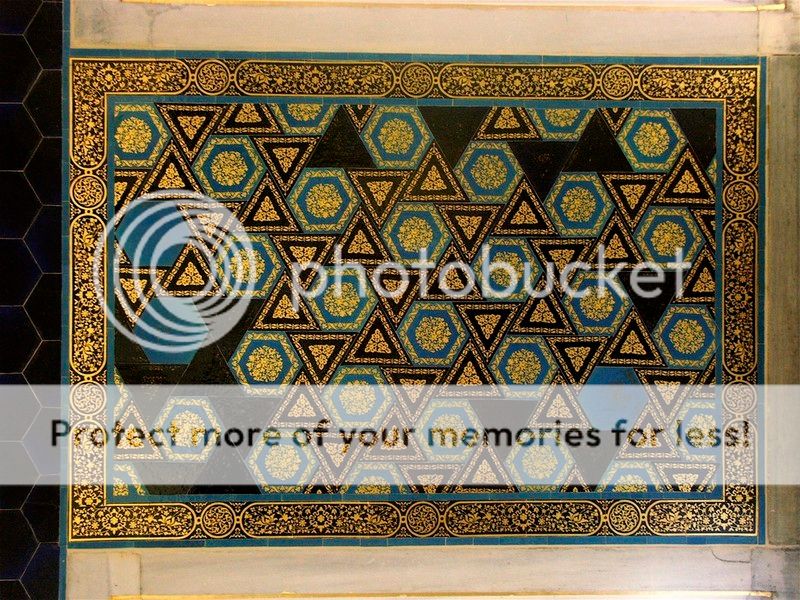GPS : 41°00'43.0"N 28°58'52.5"E / 41.011941, 28.981260

PHOTOGRAPHS ALBUM
FOUNTAIN OF YOUTH
Gallery 2 : One of the niches of the room in the left corner against the Gülhane Park was transformed into a fountain in the era of Sultan Murad III (1574-1595). The figure of peacock in the middle of herbal motifs on the stone plate attracts interest. The ornaments are hand-carved and gilded. From the two marble inscriptions of twelve verses carved in Nastaleeq script on the two sidewalls of the fountain, it is understood that it was built in the year of 999 according to the Islamic calendar (1590 AD) and that the Tiled Kiosk was called the "Glazed Palace" in those years.
During the last rearrangements, a reproduction of Osman Hamdi Bey's oil painting "Fountain of Youth" (Ab-ı Hayat Çeşmesi), dating from 1904, was placed to the niche against the fountain. For this painting, Osman Hamdi Bey had used the photo taken while he was standing next to the fountain.
TILE MIHRAB
Gallery 3 : This tile mihrab from the Karamanoğlu İbrahim Bey Imaret (public kitchen) built in 1432 is dated to circa second half of the 14th century or early 15th century was made using the colorful glazing technique, which was popular in the early Ottoman era, and is placed in the middle gallery, on the right side of the entrance.
The İbrahim Bey Imaret was ruined in the course of time, and the mihrab was transferred to İstanbul in late 19th century by the order of Halil Edhem Bey and it was mounted to its current place in the Tiled Kiosk Museum in early 20th century. On the inscription panel of the mihrab consisting of tile plates ornamented with herbal and geometric figures, there are the 255th verse (ayat) of the Sura (chapter) Al-Baqara (Ayet ul Kursi) in Naskh script and the 256th and 257th verses in Kufic script.
CANDLE - ARTIFACTS MADE IN İZNİK
Gallery 3 : A new era opened in the workshops of İznik in late 15th century-early 16th century. The settlement of tile masters in İznik and their communication with the Nakkashane (the atelier of the miniature and illumination artists) built in the Topkapi Palace by Sultan Mehmed II the Conqueror (1451-1481) accelerated the stylistic development. This candle, one of the highest quality examples of earthenware of the Ottoman era with the Islamic creed (Shahada) written on its neck was made for the Sokullu Mehmed Pasha Mosque (1571-1572) in Kadırga, İstanbul. It is possible to observe the "coral red", the most apparent characteristic of the 16th century, on this artifact.
CANDLE HANGER (ORNAMENTAL BALL) - ARTIFACTS MADE IN KÜTAHYA
Gallery 5 : From the beginning on, the tile and ceramic production in Kütahya followed a path parallel to the development in İznik. According to scientific analyses on tile and ceramic works in İznik and Kütahya, the same technologies were used in both cities except a few differences. In early 18th century, the production in İznik ended finally, but the workshops in Kütahya continued to exist thanks to their production policies oriented towards the needs of the people and to their characteristic style.
The artifacts in the collections of the museum originating from Kütahya date from the 18th century to the early 20th century. The Seraphim (angel) figure on the candle hanger that is made for a church and dated to the second half of the 18th century attracts interest. The usually egg-shaped candle hangers are hanged on candles with chains.
PLATE - ÇANAKKALE
Gallery 6 : From the late 17th century to the first quarter of 20th century, Çanakkale is a local center of ceramics distinguished from İznik and Kütahya by its works with different forms and interesting figures. Travelers who visited Çanakkale mentioned the ceramic works produced in this city. The artifacts in this exhibition belong to the period between the 18th century and the early 20th century. This plate, with a giraffe silhouette in the middle of stylistic trees, is one of the high quality examples dated to the second half of the 19th century.
LOCATION SATELLITE MAP
WEB SITE : Istanbul Archaeological Museums Administration
MORE INFO & CONTACT
Tel : +90 212 520 7740
Fax : +90 212 527 4300
E-Mail : info@istanbularkeoloji.gov.tr
These scripts and photographs are registered under © Copyright 2017, respected writers and photographers from the internet. All Rights Reserved.
No comments:
Post a Comment